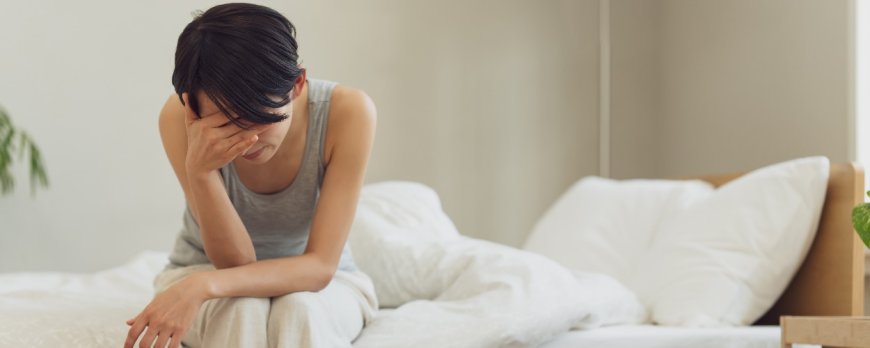What is the 333 rule for anxiety?
Uncover the potential of the 333 rule for anxiety. Learn how this simple mindfulness technique can help calm your mind when anxiety strikes.

What is the 333 rule for anxiety?
The 333 rule is a simple mindfulness technique that can help individuals cope with anxiety episodes. It involves looking around your current environment and engaging your senses to ground yourself in the present moment. By naming three things you see, identifying three sounds you hear, and moving or touching three things, you can redirect your focus away from anxious thoughts and calm your mind.
Key Takeaways:
- The 333 rule is a grounding technique for managing anxiety.
- It involves noticing and naming three things you see, three sounds you hear, and moving or touching three things.
- Although there is no formal research on its effectiveness, many people find it helpful for managing anxiety in the moment.
- The 333 rule can complement other anxiety coping strategies like taking a time-out, minimizing alcohol and caffeine intake, practicing mindfulness, paying attention to breathing, and participating in activities like meditation or exercise.
- Anxiety disorders are common and can be treated with therapy, medication, and lifestyle changes.
Understanding the 333 Rule for Anxiety
To better understand the 333 rule for anxiety, it is important to explore its components and how they contribute to anxiety management. This grounding technique is designed to help individuals bring their focus back to the present moment, providing a sense of control and relief during episodes of anxiety.
The 333 rule involves three simple steps: looking around your current environment and naming three things you see, identifying three sounds you hear, and moving or touching three things. By engaging your senses and redirecting your attention to the present, this technique aims to disrupt anxious thoughts and promote a sense of grounding.
While there is no formal research on the effectiveness of the 333 rule, many individuals report finding it helpful for managing anxiety in the moment. It is important to note that this technique is not a substitute for professional treatment, but rather a tool that can complement other coping strategies.
Some additional strategies that can be used in conjunction with the 333 rule include taking a time-out, minimizing alcohol and caffeine intake, practicing mindfulness, paying attention to breathing, and participating in activities like meditation or exercise. These approaches, along with therapy, medication, and lifestyle changes, are commonly used to treat anxiety disorders.

How does the 333 rule help with anxiety?
The 333 rule offers a practical approach to anxiety by redirecting attention and grounding individuals in the present moment. By engaging the senses and focusing on the immediate surroundings, this technique can help alleviate anxious thoughts and promote a sense of calm. While there is no formal research on its effectiveness, many people find it helpful for managing anxiety in the moment.
When practicing the 333 rule, individuals are encouraged to look around their current environment and consciously name three things they see. This visual identification helps to shift focus away from anxious thoughts and onto the present moment. Additionally, individuals are prompted to identify three sounds they hear, further grounding them in their surroundings and diverting attention away from worrisome thoughts.
The final step of the 333 rule involves moving or touching three things. This physical interaction with the environment reinforces the connection to the present moment and helps to anchor individuals in reality. By engaging the senses and redirecting attention from anxiety-provoking thoughts, the 333 rule can provide a sense of relief and promote a greater sense of control over anxiety symptoms.
Complementing other coping strategies
Although the 333 rule can be a helpful tool in managing anxiety, it is important to note that it is not a substitute for professional treatment. However, when used in conjunction with other coping strategies, it can be a valuable addition to an individual's anxiety management plan.
Some other techniques that can complement the 333 rule include taking a time-out from stressors, as well as minimizing the intake of substances such as alcohol and caffeine, which can exacerbate anxiety symptoms. Additionally, practicing mindfulness and paying attention to breathing can help individuals stay present and reduce anxiety. Engaging in activities like meditation or exercise can also provide a positive outlet for stress and promote overall well-being.
Ultimately, the 333 rule can serve as a tool for individuals to manage their anxiety symptoms in the moment. By practicing this technique and incorporating other coping strategies, individuals can develop a comprehensive approach to anxiety management that supports their overall well-being.
Benefits of the 333 Rule for Anxiety
By practicing the 333 rule, individuals may experience various advantages in terms of anxiety reduction and increased mindfulness. This grounding technique can help individuals shift their focus from anxious thoughts to their immediate surroundings, promoting a sense of calm and presence in the moment. Here are some of the potential benefits of incorporating the 333 rule into anxiety management:
- Anxiety relief: Engaging in the 333 rule can provide temporary relief from anxiety symptoms by redirecting attention away from overwhelming thoughts and into the present moment.
- Increase in mindfulness: The 333 rule encourages individuals to observe their surroundings with greater awareness, fostering a sense of mindfulness and helping them become more attuned to the present moment.
- Cognitive distraction: Naming three things you see, three sounds you hear, and moving or touching three things can serve as a cognitive distraction, interrupting anxious thought patterns and promoting a sense of clarity.
- Easy to implement: The simplicity of the 333 rule makes it easily accessible for individuals experiencing anxiety. It can be practiced anywhere, at any time, providing a quick and effective tool for managing anxiety on the go.
It's important to note that while the 333 rule can be a helpful tool in the management of anxiety, it is not a substitute for professional treatment. Individuals with anxiety disorders should seek guidance from mental health professionals who can provide a comprehensive treatment plan tailored to their specific needs. The 333 rule can be used in conjunction with other coping strategies, such as taking breaks, reducing alcohol and caffeine intake, practicing mindfulness, paying attention to breathing, and engaging in activities like meditation or exercise.
Anxiety disorders are common and can be effectively managed with a combination of therapy, medication, and lifestyle changes. If you or someone you know is struggling with anxiety, reach out to a healthcare provider for support. Remember, you don't have to face anxiety alone, and there are resources available to help you navigate your journey towards better mental well-being.

Implementing the 333 rule for anxiety relief
Incorporating the 333 rule into your anxiety management routine can be a valuable tool for finding relief in challenging moments. This grounding technique involves engaging your senses and redirecting your focus to the present moment. By taking a few minutes to practice this technique, you can help alleviate anxiety symptoms and regain a sense of control.
To implement the 333 rule, start by looking around your current environment and consciously identifying three things you see. It can be as simple as noticing the color of the walls, the texture of an object, or the patterns in a painting. This exercise helps to redirect your mind from anxious thoughts and brings your attention to the present moment.
Next, identify three sounds you hear. It could be the sound of birds chirping, the hum of a computer, or the distant sound of traffic. Bringing awareness to the sounds around you can anchor your focus and provide a sense of grounding and calm.
Finally, move or touch three things. This can be as simple as tapping your fingers on a table, feeling the texture of a fabric, or stretching your muscles. Engaging your sense of touch helps to bring you back into your body and can alleviate anxiety by promoting a sense of physical presence and relaxation.
Remember, the 333 rule is not a substitute for professional treatment, but it can complement other coping strategies for anxiety management. Consider integrating this technique into your routine, alongside practices such as taking a time-out, minimizing alcohol and caffeine intake, practicing mindfulness, paying attention to breathing, and participating in activities like meditation or exercise. By adopting a holistic approach to anxiety management, you can find relief and improve your overall well-being.
Techniques for Anxiety Using the 333 Rule
Alongside the 333 rule, there are various techniques that can be combined to create a comprehensive anxiety management approach. These techniques can further enhance the effectiveness of the 333 rule and provide individuals with additional coping strategies for managing anxiety.
1. Taking a Time-Out
When anxiety strikes, it can be helpful to take a step back and give yourself a time-out. Find a quiet and comfortable space where you can relax and collect your thoughts. Take deep, slow breaths to help calm your mind and body. Engaging in activities such as listening to calming music, practicing meditation, or doing a relaxing hobby can also aid in reducing anxiety levels.
2. Minimizing Alcohol and Caffeine Intake
Both alcohol and caffeine can exacerbate anxiety symptoms. It's important to minimize or avoid their consumption, as they can increase feelings of restlessness, irritability, and amplify anxious thoughts. Opt for herbal teas or decaffeinated beverages instead, and be mindful of any hidden sources of caffeine in your diet.
3. Practicing Mindfulness and Paying Attention to Breathing
Mindfulness practices, such as meditation and deep breathing exercises, can be incredibly beneficial for anxiety management. These techniques help bring your focus to the present moment, allowing you to observe and accept your thoughts and emotions without judgment. Take a few moments each day to practice mindfulness, paying attention to your breath as it enters and leaves your body. This can help promote relaxation and reduce anxiety over time.
Remember, while the 333 rule and these techniques can be helpful in managing anxiety, they are not meant to replace professional treatment. If you are struggling with anxiety disorders, it's important to seek guidance from a mental health professional who can provide appropriate therapy, medication, and help you make necessary lifestyle changes to support your mental well-being.
Steps to follow for the 333 rule in anxiety management
Following specific steps can help individuals effectively integrate the 333 rule into their anxiety management routine. This grounding technique provides a simple framework for redirecting your focus away from anxious thoughts and towards your immediate surroundings.
To begin, find a quiet and comfortable space where you can sit or stand without distractions. Take a deep breath and allow yourself a moment to center your thoughts. Then, follow these steps:
- Look around and identify three things you can see. It could be objects in the room, colors, or textures. Take a moment to observe them and mentally note their presence.
- Listen carefully and identify three sounds you can hear. It could be the hum of the air conditioner, birds chirping outside, or the rustling of leaves. Focus on each sound and acknowledge its presence.
- Moving or touching three things around you can help bring you into the present moment. It could be as simple as tapping your fingers on a table, feeling the texture of your clothing, or stretching your arms. Allow yourself to physically engage with these objects.
The 333 rule is not a magical cure for anxiety, but it can serve as a helpful tool in managing anxiety symptoms in the moment. It serves as a short-term strategy to ground yourself and regain a sense of control over your thoughts and emotions. Remember, it is important to seek professional help if you are experiencing persistent or severe anxiety symptoms.

Taking a Time-Out for Anxiety Management
Incorporating regular time-outs into your routine can significantly contribute to effectively managing anxiety symptoms. Taking a break from stressors allows you to recharge and restore your mental and emotional well-being. Here are some strategies to consider:
- Practice deep breathing: Deep breathing exercises can help calm your mind and body, reducing anxiety levels. Take slow, deep breaths in through your nose, hold for a few seconds, and exhale slowly through your mouth. Repeat this process several times, focusing on the sensation of your breath flowing in and out.
- Engage in mindfulness activities: Mindfulness encourages you to be present in the moment and fully aware of your thoughts and feelings. Try engaging in activities that promote mindfulness, such as meditation, yoga, or even going for a walk in nature. These practices can help you become more grounded and less consumed by anxious thoughts.
- Create a peaceful environment: Find a quiet and comfortable space where you can relax and unwind. Surround yourself with calming elements like soft lighting, gentle music, or aromatherapy. This dedicated space can serve as a refuge during times of heightened anxiety.
Seeking Professional Help
While these strategies can be beneficial for managing anxiety, it's important to remember that they are not a substitute for professional help. If you are experiencing persistent anxiety symptoms or if your anxiety significantly interferes with your daily life, seek guidance from a mental health professional. They can provide you with personalized strategies, therapy, or medication options that best suit your needs.
Anxiety disorders are common and can be effectively treated. A combination of therapy, medication, and lifestyle changes can help individuals overcome and manage their anxiety symptoms. By taking the time to implement self-care practices and seeking professional help, you can regain control over your anxiety and live a more fulfilling life.
Minimizing alcohol and caffeine intake for anxiety management
Making conscious choices to limit alcohol and caffeine consumption can have a positive impact on anxiety symptoms. While alcohol and caffeine are commonly consumed substances, they can potentially exacerbate anxiety and contribute to feelings of restlessness and unease. By understanding the effects these substances have on the body and mind, individuals can take steps to minimize their intake and promote better anxiety management.
Effects of alcohol on anxiety
- Alcohol is a depressant that can initially provide a sense of relaxation and temporarily alleviate anxiety symptoms in some individuals.
- However, alcohol can disrupt sleep patterns, interfere with the regulation of neurotransmitters in the brain, and lead to increased feelings of anxiety and depression over time.
- Therefore, reducing alcohol consumption or avoiding it altogether can help stabilize mood and improve overall anxiety management.
Impact of caffeine on anxiety
- Caffeine is a stimulant that can increase heart rate, promote alertness, and enhance feelings of anxiety and nervousness.
- Consuming excessive amounts of caffeine, especially in the form of energy drinks or strong coffee, can lead to heightened anxiety and restlessness.
- Individuals with anxiety disorders may be more sensitive to the effects of caffeine, making it important to monitor and limit their intake.
Taking control of alcohol and caffeine consumption is just one aspect of managing anxiety effectively. It is essential to consult with healthcare professionals, therapists, or counselors to develop a comprehensive anxiety management plan that includes appropriate treatment, therapy, and lifestyle changes. By combining strategies like taking breaks, practicing mindfulness, paying attention to breathing, and engaging in activities such as meditation or exercise, individuals can take significant steps towards reducing anxiety and improving their overall well-being.
Practicing mindfulness and paying attention to breathing
Incorporating mindfulness techniques and breath awareness into your daily routine can assist in alleviating anxiety symptoms. Mindfulness involves bringing your attention to the present moment and observing your thoughts and sensations without judgment. It can help you become more aware of your anxiety triggers and provide a sense of control over your internal thoughts and emotions.
One way to practice mindfulness is by engaging in deep, diaphragmatic breathing exercises. These exercises focus on taking slow, deep breaths, filling your lungs and abdomen with air, and exhaling slowly. Paying attention to your breath can help calm your nervous system and reduce physiological symptoms of anxiety, such as rapid heartbeat and shortness of breath.
Additionally, you can incorporate other mindfulness techniques into your daily routine to manage anxiety. These may include:
- Body scan meditation: Starting from your head and moving down to your toes, progressively relax each part of your body while focusing on the physical sensations.
- Guided imagery: Using your imagination, visualize a peaceful and calming place, engaging your senses to create a vivid mental image.
- Awareness of sensations: Tune into the physical sensations of your body, such as the feeling of your feet on the ground or the sensation of air on your skin.
By regularly practicing mindfulness and breath awareness, you can develop a greater sense of calm and reduce the impact of anxiety in your daily life.
Participating in activities like meditation or exercise for anxiety management
Including activities like meditation or exercise in your routine can enhance overall well-being and help reduce anxiety levels. These practices have been shown to have numerous mental health benefits and can be effective tools for managing anxiety.
Meditation:
Meditation is a mindfulness practice that involves focusing your attention and eliminating the stream of thoughts that may be causing anxiety. By dedicating just a few minutes each day to meditation, you can cultivate a sense of calm and relaxation. Start by finding a quiet space where you can sit comfortably. Close your eyes and take slow, deep breaths. Focus on your breath and let go of any racing or intrusive thoughts. If your mind wanders, gently bring your attention back to your breath. With regular practice, meditation can help you develop a greater sense of self-awareness and reduce anxiety symptoms.
Exercise:
Incorporating regular exercise into your routine can also have a significant impact on anxiety management. Physical activity releases endorphins, which are natural mood-boosting chemicals in the brain. Exercise can help reduce stress, improve sleep, and increase overall feelings of well-being. You don't have to engage in intense workouts to experience the benefits; even moderate activities like walking, yoga, or cycling can be beneficial for reducing anxiety. Find an exercise that you enjoy and make it a regular part of your routine to reap the anxiety-relieving benefits.
While activities like meditation and exercise can be powerful tools for managing anxiety, it's important to remember that they are not standalone treatments. It's essential to seek professional help if you are struggling with anxiety disorders. A mental health professional can provide you with a personalized treatment plan that may include therapy, medication, and lifestyle changes.
Conclusion
While the 333 rule can be a helpful technique for managing anxiety in the moment, it is important to remember that it should complement other evidence-based strategies and treatments for anxiety disorders. Anxiety disorders are common and can be treated with therapy, medication, and lifestyle changes.
The 333 rule, a grounding technique for coping with anxiety, involves looking around your current environment and naming three things you see, identifying three sounds you hear, and moving or touching three things. Although there is no formal research on its effectiveness, many people find it helpful for managing anxiety symptoms.
However, it is crucial to note that the 333 rule is not a substitute for professional treatment. It can be a useful tool to incorporate alongside other coping strategies such as taking a time-out, minimizing alcohol and caffeine intake, practicing mindfulness, paying attention to breathing, and participating in activities like meditation or exercise.
If you are experiencing anxiety disorders, it is essential to seek guidance from qualified professionals who can provide therapy, prescribe medication if necessary, and help you make lifestyle changes that promote overall well-being. Remember, while the 333 rule may provide temporary relief, a comprehensive treatment plan tailored to your specific needs is key to long-term anxiety management.


































































































































